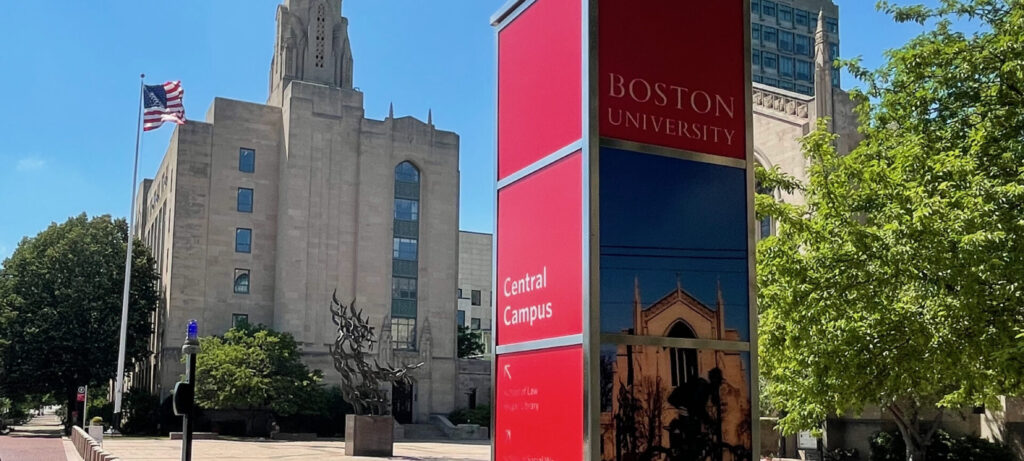Forr Education: Interview Series About Tech’s Role In The Student Experience — Tracy Schroeder, VP Of IS&T, Boston University

Photo: Brent Ellis
Higher education institutions are driven to improve customer experience (CX) by competitive pressures related to the future of work and an evolving understanding of what the important aspects of a formal education entail.
The student experience, however, is far more than the three E’s of customer experience — ease, effectiveness, and emotion. For students enrolled in a degree or certificate program, their satisfaction with the institution they’ve chosen looks a lot like the factors involved in employee experience — empowerment, enablement, and inspiration.
To learn how university IT groups can help empower students, we interviewed Tracy Schroeder, Boston University’s VP of information services and technology (IS&T). She shared with us her journey in making a shared governance model work at BU — and the iterations she went through to create a system for addressing student needs so they felt heard and empowered with regards to technology at Boston University. (To learn more about the BU IT Governance Structure, please go here.)
Brent: So, first up, can you talk a little bit about what you saw at Boston University when you first arrived as the vice president of IS&T?
Tracy: Okay, in 2009, central IT was not even one organization. It was at least two — arguably four — in addition to a bunch of local IT support organizations. Central IT was a combination of a historical administrative computing group and an academic computing group. There was also a centrally sponsored tertiary group that did a blend of both. Over the years, these separate groups’ services had come to overlap on even fundamental things like AD, identity and access management, network management, email, storage, and other basic commodity IT services that benefit from scale.
When considering the central IT group as a service provider to the community at large, it wasn’t well positioned. First, it needed to be consolidated internally. Culturally, it also had a history of independent action based upon its own notion of what was good for the community. There were cases where they created new applications without clear sponsorship and — without client involvement — then presented them to stakeholders as a sort of gift.
Unfortunately, it was not a gift they had asked for, and they were frustrated instead of pleased. The stakeholders instead wondered why their various other needs weren’t being addressed. I heard these stories in listening sessions with stakeholders and also took a survey of the community. There was a general feeling that central IT was unaccountable.
Historically, this makes sense for a research university where the IT department grew up out of computer science. There was an early organic development of technical capabilities, but IT wasn’t originally conceived as a formal set of services meant to be broadly used. So, the whole notion of a formal IT service management approach was foreign to BU when I arrived — maybe even countercultural.
Brent: When you were looking at reshaping that landscape, did you take particular notice of the student experience and how to incorporate their experience of technology into that planning and prioritization process?
Tracy: I did. Though I confess, I failed in my first attempts to respond to their needs. I started with a community-wide assessment. I received community satisfaction survey data from each major role (except alumni) — students, faculty, and staff. Then I could break them all down by a school, college, department, etc.
Faculty were the least satisfied, likely because they have the highest bar for what they want. Students were relatively satisfied overall but showed dissatisfaction with certain key services: specifically, wireless, printing, and student administrative services.
Students were my biggest customer base. But in terms of how to engage them — how to formulate the governance process — I actually did not go the route of having role-oriented governance committees (i.e., a staff governance committee, a faculty governance committee, and a student governance committee). Instead, I thought it was important to orient IT around the services it provides, because many services are broadly shared across all roles at the institution. So, we started with a service catalog. We then created a governance process by category of service.
To address the historical sense that IT had a lack of accountability, I went big with the governance process. I created six committees — large committees, like 25 people on each committee. In each, I went for a cross section of people from all roles on each committee, but the committees were weighted toward certain roles based upon service area. For instance, the research computing committee and the teaching and learning committee were faculty-heavy, whereas the administrative systems committee was staff-heavy. I also created a communication and collaboration, client computing, and common services and information security committee.
I initially tried having students who were nominated by the dean of students’ office on each of these committees. What I found over a period of about five years of trying different approaches to recruiting and retaining those students was that for getting students to engage, the most important thing was the logistics of meeting attendance. Most of the meetings for these committees were during the day; it wasn’t practical for students.
We had a handful of students, probably three or so who were really engaged and impactful in those committees, but most were not; most were not able to attend regularly. Also, most students did not feel connected to what we were discussing because their interests were much narrower: Wi-Fi, printing, labs, and registration.
What I ended up doing about five years ago was creating a specific student technology advisory council comprised wholly of students. I solicited the nominations from the schools and colleges directly as well as the dean of students, and I invited more students than I expected to attend. I had double the number of students that I needed enrolled, and I only expected to get maybe a third of them at a time. The meetings were usually in the evenings, and there was always food. Participation for our remote meetings have been interesting over the past year and a half. They’ve been well attended, and I’ve sent students Grubhub gift certificates afterward.
With this new model, I’ve gotten reasonable turnout, and what we’ve done is made it much less like the other governance committees, which are focused on a combination of member-driven and IS&T-driven content around initiatives to be reviewed or prioritization scoring. In the student group, I’ve taken a student-driven approach. We show up, and we go around the table and say, “What matters to you right now? What’s going on? What do you want to talk about?” With that approach, IT can quickly gather items that students are interested in addressing. Some items get very specific, like the need for a printer in a particular location or a computer lab needing a particular application.
It’s been interesting to see those students — the ones who do engage — come regularly, and they’re proud of stuff that they’ve gotten us to do. They talk about it with other students. We’ve even expanded this to the medical campus. This Student Technology Advisory Council (STAC) has been able to get a number of things done that those students care about and that, frankly, no other governance committee would have gotten done.
Brent: I know you publish a lot of your metrics on the BU tech website. With regards to the STAC, do you also keep a backlog of some of these things that the STAC is advising toward?
Tracy: We keep a backlog that only the STAC sees — sort of a running agenda for that group. For the items that make sense, we post publicly. I think the students have found this format much more satisfying. We just focus in on what they care about and then follow up on those items week over week and meeting over meeting. We also scaled down the number of meetings to two meetings per semester: two in the fall and two in the spring.
Brent: Are there any questions that I didn’t ask that you think I should ask with regards to empowering students from a technology perspective?
Tracy: I think some of the tough issues are how to deal with turnover since the student population is naturally transient and how to get a diversity of student perspectives.
Regarding diversity, deans tend to nominate students who they believe are technically savvy or technically interested, which isn’t necessarily the student I should be talking to. IT needs to be talking to a diverse array of students across the spectrum of gender, age, race, ethnicity, etc., especially the students who struggle with the technology. It’s important to be aware that you need a diversity of perspectives and not just those students interested in technology.
The question of how to get diversity among student members of IT governance bodies is a challenge, and it requires both intentionality and outreach.
